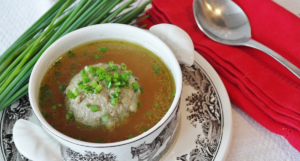The Health Benefits of Bone Broth
Did someone say bone broth benefits? With the start of the new year comes “resolution season” and a renewed emphasis on personal health and fitness. This year, there are plenty of new buzz words circulating around that have to do with losing weight and getting in shape…words like keto and paleo and bone broth benefits. While, unfortunately, there is no magic wand for quick and easy weight loss, there are some techniques that have been scientifically proven to enhance overall health. One of these is bone broth.
What is Bone Broth?


History of Bone Broth


Hunting meat was a dangerous and taxing endeavor for our ancient ancestors. Successful hunts were not an everyday occurrence so ancient man had to make good use of every part of the animal. Nothing went to waste. They used the animals’ hides for clothing, shoes, shelter, and weapons. They even found an ingenious way to make good use out of the bones and hooves. They heated the bones over their fires to break down the tough exteriors and extract the nutrients.
Soon, they discovered ways to boil the bones in water. This was no easy feat before the invention of metal pots, yet ancient man was clever enough to find ways to accomplish this long before the introduction of the metal cooking vessel. Water-tight containers were made using animal organs, animal skins, carved stone, wood, and even tightly-woven grasses. These types of cooking vessels could not be place directly over a fire. Instead, the cook would heat rocks in the fire and plunge them one by one into the vessel to heat up the water enough to simmer the bones. As you can imagine, this was a time-consuming task.
When early man learned to work with metals, he was able to fashion all sorts of tools to help make life easier. One of these was the humble cooking pot. Because it could sit directly on the fire without destroying it, the pot was a game changer. Bone broth became much easier to make and consume the bone broth benefits.
Bone broth never fell out of fashion. On the contrary, its medicinal properties were becoming widely known. Traditional Chinese medicine touted the consumption of bone broth soup at the start of every meal as a way to aid in digestion. The Greek physician, Hippocrates, recommended drinking bone broth to help alleviate kidney and stomach issues. South American cultures, noting the health benefits of bone broth, had a saying, “good broth can raise the dead.” On many islands in the Caribbean, people started their days with a bowl of bone broth they affectionately call “cow foot soup.” Throughout Europe and the Middle East, bone broth was given to people suffering from colds and respiratory complaints. From this, we get the old wives tale that says chicken noodle soup cured colds.
Bone broth, however, acquired a bad reputation in the twentieth century, thanks to the introduction of MSG. In 1908, a Japanese chemist created monosodium glutamate, or MSG, as an artificial meat flavoring. A broth could be made using MSG that would taste just like bone broth, but it was much cheaper and much quicker to make. Unfortunately, food manufacturing companies began replacing actual bone broth with MSG broth, which is extremely high in sodium and lacks the nutrients and bone broth benefits. Today, most of the commercially-made broths that are sold in supermarkets contain no animal bones, just MSG.
In the last few years, however, bone broth is making a comeback. More and more consumers are rejecting commercially-made food products that rely on chemicals and artificial ingredients in favor of more traditionally-made foods. People are rediscovering bone broth and the health benefits it brings, making bone broth one of the hottest health food trends today.
Bone Broth Versus Soup Stock
Just like there is a difference between broth made with MSG and bone broth, there is a difference between bone broth and vegetable stock. Although vegetable stock, if made with fresh, natural ingredients, is healthier than MSG broth, it lacks the rich nutritional bone broth benefits. The biggest differences between bone broth and vegetable stock are the part of the animal from which it is made and the length of time the broth simmers.
When making soup stock, typically the meat or flesh of the animal is boiled along with vegetables, herbs, and spices. Although some bones may be added to the mix, the stock is primarily made with bits of meat and vegetables. True bone broth, on the other hand, is made using animal bones, along with connective tissues. Very little meat, if any, is left on the bones.
The simmering time differs greatly, too. Soup stock is simmered for a much shorter period of time…usually between two and five hours. This length of time does not allow for large amounts of nutrients to be leached out of the bones, reducing the health benefits. But with bone broth, which has a simmering time of between twelve and twenty hours, the bones and connective tissue have enough time to fully break down and release the many bone broth benefits.
Bone Broth Benefits for Your Health


The Common Cold
Chicken noodle soup has long been the go-to for people suffering from the common cold and other respiratory ailments. In fact, a 2000 study that was published in the journal of the American College of Chest Physicians found that soup, specifically soup made with bone broth, does aid in relieving the symptoms of the common cold. The bone broth helps to open clogged nasal passages, clear mucus, sooth scratchy throats, and ease digestion. Dr. Irwin Ziment, a professor and researcher at UCLA, even discovered that chicken soup made with bone broth contains high amounts of an amino acid called cysteine, which has the same chemical make up as acetylcysteine, a common drug used to treat bronchitis.
Related Article: Turmeric Tea
Inflammation
The amino acids found in bone broth are also effective at reducing inflammation. The collagen adds to the anti-inflammatory properties as well. Joint pain and stiffness, from conditions such as rheumatoid arthritis, can be reduced by adding bone broth to your diet.
Immunity Boost
The cysteine, arginine, and glutamine amino acids in bone broth help the body boost its natural immune system so that it is better able to fight off diseases. In fact, bone broth is just as powerful at increasing immunity as vitamin C.
Strengthening Bones and Teeth
Building and strengthening bones and teeth requires a regular supply of many different nutrients and minerals, including calcium, iron, potassium, vitamin D, protein, zinc, vitamin C, magnesium, boron, copper, and the B vitamins. All of these and more can be found in bone broth. Routinely consuming bone broth will give your body a steady stream of these vital vitamins and minerals.
Building Muscle
A process called muscle protein synthesis is needed for your body to grow, maintain, and repair the different muscle groups in the body. Amino acids are how that process is stimulated. Several on-going research studies have shown the connection between amino acids and the process of muscle protein synthesis; therefore, regularly eating bone broth is an ideal way to boost your intake of amino acids and gain all the bone broth benefits.
Weight Loss
Preliminary research seems to show a relationship between gut bacteria and weight loss. Obese people tend to have more of one kind of gut bacteria, Firmicutes, and less of another, Bacteroidetes, than slimmer, fitter people. This led researchers to study the impact of gut bacteria on weight and digestion. One theory is that the larger amount of Firmicutes means the body is pulling more calories from the food that is being digested, so researchers are looking at ways to alter the ratio of Firmicutes to Bacteriodetes in the stomach. An amino acid called L-glutamine has been shown to decrease the amount of Firmicutes. Bone broth is high in L-glutamine, therefore regularly consuming bone broth could be a factor in weight loss.
Ancient Chinese medicine advised drinking bone broth at the start of every meal. Now, researchers are re-examining this practice to see if when the bone broth is consumes is important to its effectiveness. Conventional logic would tell us that drinking a bowl of any liquid right before a meal would fill up the stomach, so a person would eat less and therefore take in fewer calories. But, when it comes to bone broth, is there more to it?
The researchers did an experiment on this. One group of test subjects drank a pre-set amount of water prior to every meal while another group drank the same amount of bone broth. The meals each group ate contained the exact same food in the same quantities. They concluded that the group that drank the bone broth before their meals experienced a reduced caloric intake from their meal. The study concluded that not all liquid is created equal and that the properties in the bone broth do make a difference.
Improved Hydration
Bone broth in general, but particularly bone broth made with added vegetables, is high in electrolytes and carbohydrates. It is much quicker and more effective at rehydrating someone who is dehydrated and suffering from electrolyte depletion. Many top athletes have found this to be true and now add a hefty dose of bone broth to their post-workout routine to take in all the bone broth benefits.
Mood Booster
Neuroscientists are beginning to unravel how the body interacts with other parts of the body. They have learned that the gut bacteria, called the microbiome, communicates with the brain. A healthy balance of gut bacteria results in a happier brain with less fatigue, better memory, improved mood, and a clearer mind that is better able to cope with outside stresses. But an unhealthy gut bacteria ratio signals the brain to respond with anxiety, stress, depression, and foul mood.
Healthier Skin and Nails
The collagen and gelatin that is released into the bone broth through the simmering process are beneficial to skin, hair, and fingernails. The restorative amino acids in the bone broth, including alanine, glycine, proline, and hydroxyproline, make skin more supple and elastic, makes fingernails stronger, and helps hair grow faster and stay healthier. In addition, the collagen has anti-aging properties to help skin look younger.
Make Your Own Bone Broth


In a large stock pot or Dutch oven, add the bones and fill with water until the bones are covered by about an inch of water. Add apple cider vinegar, bay leaves, and chopped vegetables such as onions, celery, and carrots. Bring the mixture to a boil and then reduce the heat to low. In fact, set the burner as low as your stove allows, and let it continue to simmer, covered, for at least twelve hours. Simmer the broth for longer if you can. Some people allow their bone broth to simmer for two full days. Remember, the longer it simmers, the more collagen and nutrients are extracted, and beef bones require a longer simmer time than poultry bones.
Once the simmering process is done, strain the broth through a fine mesh strainer or a cheese cloth to remove the bites of bone, leaving just the liquid. You can store the bone broth in glass canning jars with lids until you are ready to use them. You will notice that when the bone broth cools, a layer of fat forms on the top. You can keep it, scrap it off and discard it, or use it for other recipes.
Related Article: Bone Broth Recipe
Bone Broth and Today’s Diet Plans


Keto Diet
The keto diet, or ketogenic diet, is a way to retrain your body so that it burns fat to get its energy instead of burning glucose. To do this, you need to put your body in a state of ketosis by sharply reducing the amount of carbs in your diet. In fact, you should strive for a balance of about 5% carbs, 20% protein, and 75% fat. By doing this, the body only has the option to use fatty acids, normally your body’s plan B, for energy since there is not enough carbs to meet the energy requirements.
Bone broth is naturally low in carbohydrates and high in protein. Adding bone broth to your Keto diet plan helps you meet the fat and protein requirements for ketosis, while keeping carbs down. You also get all the nutrients, amino acids, and gut bacteria benefits of bone broth, too.
Paleo Diet
Also called the caveman diet, the paleolithic diet aligns with the belief that the rise in obesity, diabetes, and heart disease in today’s society is the result of over-processed, high sugar, high fat foods, mixed with a sedentary lifestyle. The answer to this, paleo diet proponents believe, is to avoid modern food and only eat they way our ancient hunter-gatherer ancestors did. The means eating only fresh fruits and vegetables, fresh lean meats, and nuts in moderation. The food should be as fresh as possible and in its most natural form…even raw. Bone broth is an ancient recipe – perhaps even used by cavemen – so it fits well into the paleo diet ideology.
Gluten Free Diet
Bone broth is gluten free unless wheat is simmered with the bone, and it rarely is. Many experts recommend that people who have celiac disease or who are committed to a gluten free diet add bone broth to their diets. The amino acids and gelatin can promote an increase in helpful gut bacteria, reduce inflammation in the digestive tract, and ease the digestive process.
Atkins Diet
Much like the keto diet and the paleo diet, the Atkins diet extols the virtues of a high protein, low carb diet. Studies have shown that the Atkins diet helps to improve blood sugar and good cholesterol. Bone broth contains fat and protein, so it makes a great addition to the diet plan for someone on the Atkins diet.
Related Article: 5 Best Natural Supplements for Diabetes
How to Work Bone Broth into Your Diet


Bone broth can serve as the basis for stews and casseroles, too. Just replace the water in the recipe with the equal amount of bone broth. The same thing goes for rice, pasta, and quinoa. You can cook with bone broth. For example, it can be used to braise meat or sauté vegetables. Bone broth can be worked into sauces and marinades to take in the bone broth benefits as well.
Bone broth can be sipped hot or chilled, like tea. It can be added to shakes and smoothies, too.
There is a reason you have been hearing more and more about bone broth in the last year or so. Modern day nutritionists and scientists have recently rediscovered the health benefits of this ancient food product and folk remedy. The long, slow simmering process releases many of the nutrients, gelatin, amino acids, and more that are trapped in the animal bones. The health benefits of bone broth are impressive. Bone broth has been used to ease digestive issues, reduce inflammation, build muscle and bone, and promote weight loss. With so many favorable bone broth benefits, it may be time to give bone broth a try.
